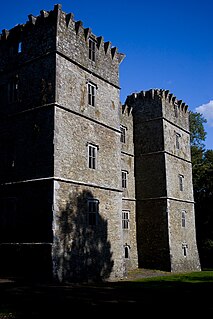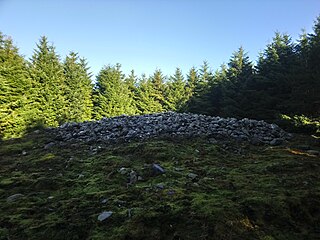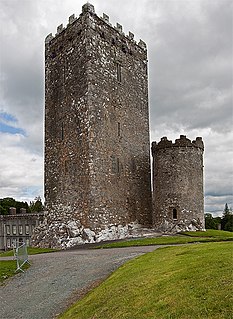The N8 road is a national primary road in Ireland, connecting Cork with Dublin via the M7. The N8 is further classified by the United Nations as the entirety of the European route E 201, part of the trans-Europe International E-road network. The road is motorway standard from junction 19 on the M7 to the Dunkettle interchange in Cork City and is designated as the M8 motorway. From here the route continues into City city centre and terminates at the N22 road at St. Patrick's Street. The M8 motorway was completed in May 2010, replacing the single carriageway sections of the old N8 and bypassing towns on the main Cork to Dublin road. It is now possible to travel from Cork to Dublin on the M/N8 in about 2 hours 30 minutes. The route commences just south of Portlaoise, and reaches Cork via the midlands and the Golden Vale of Ireland, through Counties Laois, Kilkenny, Tipperary, Limerick and Cork.

Fermoy is a town on the River Blackwater in east County Cork, Ireland. As of the 2016 census, the town and environs had a population of approximately 6,500 people. It is located in the barony of Condons and Clangibbon, and is in the Dáil constituency of Cork East.

Kanturk is a town in the north west of County Cork, Ireland. It is situated at the confluence of the Allua (Allow) and Dallow (Dalua) rivers, which stream further on as tributaries to the River Blackwater. It is about 50 kilometres from Cork, Blarney and Limerick, and lies just north of the main N72 road, 15 km from Mallow and about 40 km from Killarney. Kanturk is within the Cork North-West Dáil constituency.

Baltinglass, historically known as Baltinglas, is a town in south-west County Wicklow, Ireland. It is located on the River Slaney near the border with County Carlow and County Kildare, on the N81 road.

Patrick Weston Joyce, commonly known as P. W. Joyce was an Irish historian, writer and music collector, known particularly for his research in Irish etymology and local place names of Ireland.

The R639 road is one of Ireland's regional roads. Once designated the N8 national primary road, it was reclassified in stages as the R639 following the progressive opening of sections of the M8 motorway, which rendered the single carriageway N8 redundant as a national primary road. By-passed sections of the old N8 were generally reclassified as R639 as soon as a new section of M8 opened, thereby increasing the length of the R639. With the completion of the M8 on 28 May 2010, the R639 now stretches from Durrow, County Laois to Cork, running through counties Laois, Kilkenny, Tipperary, Limerick and Cork.

Tibradden Mountain is a mountain in County Dublin in Ireland. Other former names for the mountain include "Garrycastle" and "Kilmainham Begg". It is 467 metres high and is the 561st highest mountain in Ireland. It forms part of the group of hills in the Dublin Mountains which comprises Two Rock, Three Rock, Kilmashogue and Tibradden Mountains. The views from the summit encompass Dublin to the north, Two Rock to the east and the Wicklow Mountains to the south and west. The geological composition is mainly granite and the southern slopes are strewn with granite boulders. The summit area is a habitat for heather, furze, gorse and bilberry as well as Sika deer, foxes and badgers. The forestry plantation on the slopes – known as the Pine Forest – contains Scots pine, Japanese larch, European larch, Sitka spruce, oak and beech. The mountain is also a site of archaeological interest with a prehistoric burial site close to the summit.

Kilbride, or Manor Kilbride, is a village, civil parish and District electoral division in County Wicklow, Ireland, located at the western edge of the Wicklow Mountains in the barony of Talbotstown Lower.
Mullaghreelan Rath is a ringfort (rath) and National Monument located in County Kildare, Ireland.

Clermont Cairn, also called Black Mountain Chambered Cairn, is a chambered cairn and National Monument located in the Cooley Mountains, County Louth, Republic of Ireland.

Dún Dealgan Motte is a motte and National Monument in Dundalk, Ireland.

Corracloona Court Tomb, commonly called Prince Connell's Grave, is a chamber tomb and National Monument located in the north of County Leitrim in the West of Ireland.
Carns Cairn is a cairn and National Monument located in County Sligo, Ireland.
Ballymacgibbon Cairn is a cairn and National Monument located in County Mayo, Ireland.
Eochy's Cairn is a cairn and National Monument located in County Mayo, Ireland.
The Seven Monuments is an embanked stone circle and National Monument located in County Galway, Ireland.
Ballintaggart Ogham Stones is a collection of ogham stones forming a National Monument located in County Kerry, Ireland.

Skeagh Cairn is a cairn and ring barrow and National Monument located in County Cork, Ireland.

Drishane Castle is a MacCarthy tower house and National Monument located in County Cork, Ireland. In modern times the name is also used to refer to the adjacent house which dates from the 18th century. It is located 2.2 km (1.4 mi) northeast of Millstreet, on the south bank of the Munster Blackwater.

Castlelyons Friary is a former Carmelite Priory and National Monument located in County Cork, Ireland.













